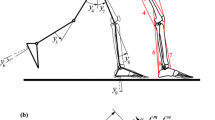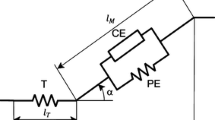Abstract
We develop methods to compute dynamics and control for articulated body systems that are actuated by linear contractile elements. We motivate the conditions under which our mathematical formulation is suitable for modeling muscle actuated robots as well as the human musculoskeletal system. In detail, we: (i) specify the conditions under which sets of piecewise linear contractile muscle fibers (actuators) can model the action of muscle volumes, (ii) use the muscle Jacobian to obtain an expression for predicting how muscle forces produce forces and accelerations at operational points on articulated bodies (muscle-to-task ‘forward’ maps), (iii) use the muscle Jacobian to obtain an expression for predicting the muscle forces required to produce specified forces at operational points on articulated bodies (task-to-muscle ‘inverse’ maps), and (iv) present an interative algorithm for resolving task-to-muscle maps with a proof of convergence and empirical results to show fast (\({\sim }20\)–100 iterations) convergence for detailed human musculoskeletal models with hundreds of muscles and tens of degrees of freedom.
Access this chapter
Tax calculation will be finalised at checkout
Purchases are for personal use only
Similar content being viewed by others
Notes
- 1.
We ignore graph topologies at the moment. Accommodating those is feasible using our methods in combination with constraint solving dynamics algorithms. See [9] for an overview.
References
Arnold, A.S., Salinas, S., Asakawa, D.J., Delp, S.L.: Accuracy of muscle moment arms estimated from MRI-based musculoskeletal models of the lower extremity. Comput. Aided Surg. 5(2), 108–119 (2000)
Asakawa, Deanna S., Nayak, Krishna S., Blemker, Silvia S., Delp, Scott L., Pauly, John M., Nishimura, Dwight G., Gold, Garry E.: Real-time imaging of skeletal muscle velocity. J. Magn. Reson. Imaging 18(6), 734–739 (2003)
Blemker, Silvia S., Asakawa, Deanna S., Gold, Garry E., Delp, Scott L.: Image-based musculoskeletal modeling: applications, advances, and future opportunities. J. Magn. Reson. Imaging 25(2), 441–451 (2007)
Blemker, Silvia S., Delp, Scott L.: Three-dimensional representation of complex muscle architectures and geometries. Ann. Biomed. Eng. 33(5), 661–673 (2005)
Boyd, S., Vandenberghe, L.: Convex Optimization. Cambridge University Press, New York (2004)
Choe, B., Ko, H.-S.: Analysis and synthesis of facial expressions with hand-generated muscle actuation basis. In: ACM SIGGRAPH 2005 Courses, p.15. ACM, Los Angeles (2005)
Demircan, E., Besier, T., Menon, S., Khatib, O.: Human motion reconstruction and synthesis of human skills. In: Lenarčič, J., Stanisic, M.M. (eds.) Advances in Robot Kinematics, pp. 283–292. Springer, Berlin (2010)
Dzahir, Mohd Azuwan Mat, Yamamoto, Shin-ichiroh: Recent trends in lower-limb robotic rehabilitation orthosis: control scheme and strategy for pneumatic muscle actuated gait trainers. Robotics 3(2), 120–148 (2014)
Featherstone, R.: Rigid Body Dynamics Algorithms. Springer, New York (2014)
Featherstone, Roy, Khatib, Oussama: Load independence of the dynamically consistent inverse of the jacobian matrix. Int. J. Robot. Res. 16(2), 168–170 (1997)
Galhano, AM., Tenreiro Machado, J.A., Martins de Carvalho, J.L.: Statistical analysis of muscle-actuated manipulators. In: Proceedings of the IEEE International Conference on Robotics and Automation, pp. 332–337. IEEE, Nice (1992)
Gil, A., Segura, J., Temme, N.M.: Numerical Methods for Special Functions. SIAM, Philadelphia (2007)
Godage, I.S., Branson, D.T., Guglielmino, E., Caldwell, D.G.: Pneumatic muscle actuated continuum arms: modelling and experimental assessment. In: 2012 IEEE International Conference on Robotics and Automation (ICRA), pp. 4980–4985. IEEE, Saint Paul (2012)
Grzeszczuk, R., Terzopoulos, D.: Automated learning of muscle-actuated locomotion through control abstraction. In: Proceedings of the 22nd Annual Conference on Computer Graphics and Interactive Techniques, pp. 63–70. ACM, New York (1995)
Hamner, S.R., Seth, A., Delp, S.L.: Muscle contributions to propulsion and support during running. J. Biomech. 43(14), 2709–2716 (2010)
Khatib, Oussama: A unified approach for motion and force control of robot manipulators: the operational space formulation. IEEE J. Robot. Autom. 3(1), 43–53 (1987)
Khatib, Oussama: Inertial properties in robotic manipulation: an object-level framework. Int. J. Robot. Res. 14(1), 19–36 (1995)
Menon, S., Migimatsu, T., Khatib, O.: A parameterized family of anatomically accurate human upper-body musculoskeletal models for dynamic simulation and control. In: Proceedings of the 2016 IEEE-RAS 16th International Conference on Humanoid Robots (Humanoids), pp. 587–594. IEEE, Cancun (2016)
Nakamura, Taro, Tanaka, Daisuke, Maeda, Hiroyuki: Joint stiffness and position control of an artificial muscle manipulator for instantaneous loads using a mechanical equilibrium model. Adv. Robot. 25(3–4), 387–406 (2011)
Nakamura, Yoshihiko, Yamane, Katsu, Fujita, Yusuke, Suzuki, Ichiro: Somatosensory computation for man-machine interface from motion-capture data and musculoskeletal human model. IEEE Trans. Robot. 21(1), 58–66 (2005)
Nakata, Y., Ide, A., Nakamura, Y., Hirata, K., Ishiguro, H.: Hop** of a monopedal robot with a biarticular muscle driven by electromagnetic linear actuators. In: 2012 IEEE International Conference on Robotics and Automation (ICRA), pp. 3153–3160. IEEE, St. Paul (2012)
Pillen, S., Tak, R.O, Zwarts, M.J., Lammens, M.M.Y., Verrijp, K.N., Arts, I.M.P., van der Laak, J.A., Hoogerbrugge, P.M., van Engelen, B.G.M., Verrips, A.: Skeletal muscle ultrasound: correlation between fibrous tissue and echo intensity. Ultrasound Med. Biol. 35(3), 443–446 (2009)
Pillen, Sigrid, van Alfen, Nens: Skeletal muscle ultrasound. Neurol. Res. 33(10), 1016–1024 (2011)
Pillen, S., van Dijk, J.P., Weijers, G., Raijmann, W., de Korte, C.L., Zwarts, M.J.: Quantitative gray-scale analysis in skeletal muscle ultrasound: a comparison study of two ultrasound devices. Muscle Nerve 39(6):781–786 (2009)
Sardellitti, I., Park, J., Shin, D., Khatib, O.: Air muscle controller design in the distributed macro-mini (dm 2) actuation approach. In: IROS 2007 IEEE/RSJ International Conference on Intelligent Robots and Systems, pp. 1822–1827. IEEE, San Diego (2007)
Seth, A., Matias, R., Veloso, A.P., Delp, S.L.: A biomechanical model of the scapulothoracic joint to accurately capture scapular kinematics during shoulder movements. PLoS One, 11(1), e0141028 (2016)
Shin, D., Sardellitti, I., Khatib, O.: A hybrid actuation approach for human-friendly robot design. In: ICRA 2008 IEEE International Conference on Robotics and Automation, pp. 1747–1752. IEEE, Pasadena (2008)
Thelen, D.G., Anderson, F.C.: Using computed muscle control to generate forward dynamic simulations of human walking from experimental data. J. Biomech. 39(6), 1107–1115 (2006)
Thelen, D.G, Anderson, F.C, Delp, S.L.: Generating dynamic simulations of movement using computed muscle control. J. Biomech. 36(3), 321–328 (2003)
Tomori, Hiroki, Nakamura, Taro: Theoretical comparison of Mckibben-type artificial muscle and novel straight-fiber-type artificial muscle. Int. J. Autom. Technol. 5(4), 544–550 (2011)
Acknowledgements
This work was supported by National Science Foundation National Robotics Initiative grant (IIS-1427396, O. Khatib and R. Bajcsy).
Author information
Authors and Affiliations
Corresponding author
Editor information
Editors and Affiliations
Rights and permissions
Copyright information
© 2020 Springer Nature Switzerland AG
About this paper
Cite this paper
Menon, S., Migimatsu, T., Khatib, O. (2020). Controlling Muscle-Actuated Articulated Bodies in Operational Space. In: Amato, N., Hager, G., Thomas, S., Torres-Torriti, M. (eds) Robotics Research. Springer Proceedings in Advanced Robotics, vol 10. Springer, Cham. https://doi.org/10.1007/978-3-030-28619-4_69
Download citation
DOI: https://doi.org/10.1007/978-3-030-28619-4_69
Published:
Publisher Name: Springer, Cham
Print ISBN: 978-3-030-28618-7
Online ISBN: 978-3-030-28619-4
eBook Packages: Intelligent Technologies and RoboticsIntelligent Technologies and Robotics (R0)




